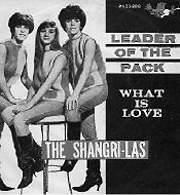New York indie rockers Versus have just released a new four-song EP (on Merge) entitled Shangri-La. In addition to the Steely Dan-esque title track, a Versus original, the disc also features their covers of identically named ditties by the Kinks and Electric Light Orchestra. But it was track 3 that immediately caught my attention: “Out in the Streets.” What’s the connection? The orig-inal version, which peaked at #53 on the Billboard charts in 1965, was performed by groundbreaking ’60s girl group the Shangri-Las.
The pop charts were rife with female vocal groups in the ’60s: the Crystals, the Chiffons, the Ronettes. In most cases (the Supremes being the most obvious exception), the songs these women made famous have outlasted their own acclaim. Any nitwit who’s ever listened to oldies radio can sing “My Boyfriend’s Back” or “Soldier Boy,” but can you name the recording artists? (The Angels and the Shirelles, respectively.) Sadly, most folks’ knowledge of the Shangri-Las ends with two big 1964 hits, “Remember (Walkin’ in the Sand)” and “Leader of the Pack,” even though they had four more Top 40 singles.
In their heyday, the Shangri-Las were peerless. Thanks to their imaginative producer, Shadow Morton, their tracks were virtual mini-movies, packed with screeching seagulls and squealing tires. Webster’s defines Shangri-La as “a remote, beautiful imaginary place where life approaches perfection.” For the heroines in this trio’s songs, “remote” and “imaginary” were the key words. Most girl groups recounted falling in love and breaking up with all the pathos of a shampoo jingle, but Mary Weiss’ spoken asides sounded as intimate as a reading from her diary, and she sang like her life depended on making each tear-streaked lyric heard round the world. Maybe she thought it did. When the Shangri-Las’ songwriters weren’t knocking off boyfriends, they took out parents (“I Can Never Go Home Anymore”) and sometimes the girlfriend, too (“Give Us Your Blessings”).
Just as importantly as their sound, no other outfit looked like the Shangri-Las. While the Crystals sported frilly dresses better suited to a garden party, Mary and identical twins Marge and Maryann Ganser (sometimes joined by Mary’s sister Betty) sported contour-hugging cat suits, Day-Glo tunics, and white vinyl go-go boots. “Girl groups overall had a very sweet image, except for maybe the Ronettes and the Shangri-Las,” notes songwriter Ellie Greenwich, who cowrote both “Leader of the Pack” and “Out in the Streets,” in Charlotte Greig’s Will You Still Love Me Tomorrow?: Girl Groups from the ’50s On . . . (Virago Press, London, 1989). “By today’s standards they were as innocent as the day is long. But back then, they had a real street toughness . . . though with a lot of vulnerability attached.”
No wonder I latched on to the Shangri-Las almost 15 years after their dissolution; street toughness with a lot of vulnerability was exactly the air I desperately aspired to project as I walked the halls of my suburban high school. (Although my friend Liesel had done an interpretative dance to “Leader of the Pack” at our fourth-grade talent show, flabbergasting us all with the finale—which involved motorcycle wreckage being thrown onstage from the wings—I was too young to appreciate the group then.) Sebastian unearthed the greatest hits LP with the song that turned my head around: “Past, Present and Future.” Over a passage lifted from Beethoven’s Moonlight Sonata, Mary delivered a stark, spoken monologue of tragedy that could only be read as a date rape—in 1966! I’d love to hear Cristina Aguilera or Mandy Moore attempt anything half as honest and gutsy today.
The Shangri-Las disbanded in 1969. At least one of the Ganser twins is now deceased (reports are varied and conflicted), and Mary’s been MIA (according to myth, she owns a furniture shop in New York) since the early ’80s. Yet Versus are hardly the first band to investigate their catalog. Over the years, Shangri-Las ditties have been resurrected by Blondie, Bette Midler, the Knoxville Girls, and the New York Dolls. Mary even came out of retirement to provide backing vocals on Aerosmith’s 1980 stab at “Remember (Walkin’ in the Sand).”
The Shangri-Las’ appeal endures today because their cuts are imbued with a pathos born from a weird but undeniable combination of melodrama and sincerity, anchored by solid songs, and crowned with cinematic production. Check out the original “Out in the Streets” from The Best of the Shangri-Las (Uni/Mercury/Polygram) and hear for yourself. Not the finest of the 25 tracks assembled, it’s almost insipid, a tale of a bad boy domesticated (at least externally) by the love of a nice suburban lass. But my Inner Teenager and I agree—even a substandard Shangri-Las original cuts to the core deeper than “What a Girl Wants” ever will.






